Architecture is a reflection of human creativity and ingenuity, often pushing the boundaries of what is deemed conventional or ordinary. While many buildings adhere to traditional designs and styles, there exists a subset of architectural wonders that defy expectations and challenge our perceptions of space, form, and function. From whimsical creations to mind-bending structures, these ten weirdest architectures scattered across the globe captivate and intrigue visitors with their unconventional designs. Join us on an exploration of these remarkable edifices that stand as testaments to human imagination and innovation.
10 Most Bizarre Buildings in the World
1. The Crooked House (Sopot, Poland)

Nestled amidst the bustling streets of Sopot, Poland, stands the Crooked House, a peculiar architectural marvel that appears to defy the laws of physics. Designed by Polish architect Szotyńscy & Zaleski, this whimsical structure resembles a fairytale cottage frozen in a state of perpetual motion. Its undulating facade and tilted walls give the impression of a building caught in a whimsical dance, drawing visitors from far and wide to marvel at its surreal beauty.
2. The Basket Building (Newark, Ohio, USA)
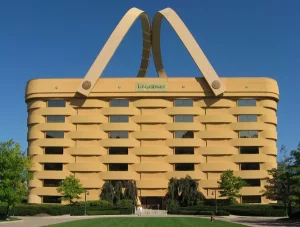
In Newark, Ohio, stands an architectural oddity that resembles a giant picnic basket frozen in time. Known as the Basket Building, this seven-story edifice serves as the headquarters of the Longaberger Company, a manufacturer of handcrafted baskets. Designed to mimic the company’s signature product, the building’s exterior is adorned with massive handles and woven details, creating a striking visual spectacle that defies convention.
3. The Dancing House (Prague, Czech Republic)
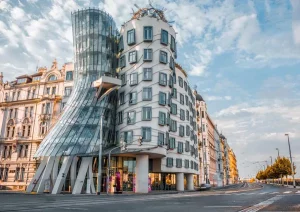
Perched on the banks of the Vltava River in Prague, the Dancing House is a striking example of postmodern architecture that challenges traditional notions of form and structure. Designed by architects Vlado Milunić and Frank Gehry, this unconventional building features undulating curves and irregular shapes, giving the impression of a pair of dancers locked in a graceful embrace. Despite initial controversy surrounding its design, the Dancing House has become an iconic symbol of Prague’s vibrant architectural landscape.
4. The Cube Houses (Rotterdam, Netherlands)
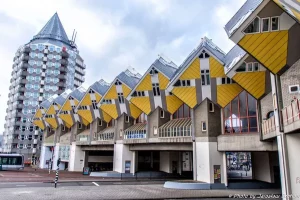
In the heart of Rotterdam, a cluster of brightly colored cubes defies the conventions of traditional urban architecture. Designed by Dutch architect Piet Blom, the Cube Houses are a series of innovative residential structures that tilt at a 45-degree angle, creating a surreal and visually captivating streetscape. Despite their unconventional appearance, the Cube Houses offer practical living spaces with a unique sense of charm and individuality.
5. The Crooked Forest (Nowe Czarnowo, Poland)
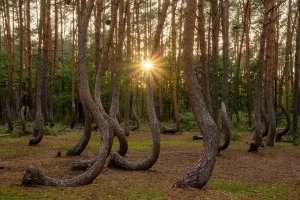
Deep in the heart of Nowe Czarnowo, Poland, lies a mysterious grove of trees that defy explanation. Known as the Crooked Forest, this enigmatic woodland is home to over 400 pine trees with mysteriously curved trunks. While the exact cause of the trees’ peculiar growth remains a subject of debate, theories range from natural phenomena to human intervention. Whatever the reason, the Crooked Forest stands as a testament to the enduring mysteries of the natural world.
6. The Upside-Down House (Szymbark, Poland)
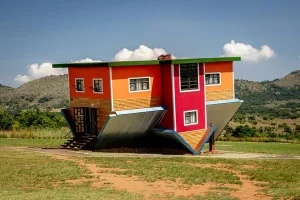
Located in the village of Szymbark, Poland, the Upside-Down House is a gravity-defying attraction that challenges visitors’ perceptions of space and orientation. Designed by Polish businessman and philanthropist Daniel Czapiewski, this whimsical structure appears to have been uprooted from its foundations and flipped upside-down, with its roof resting on the ground and its windows and doors suspended in mid-air. Inside, visitors navigate through rooms furnished with upside-down furniture, creating a disorienting and surreal experience.
7. The Stone House (Guimarães, Portugal)
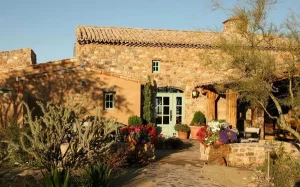
Nestled amid the rugged landscape of Guimarães, Portugal, the Stone House is a striking example of architectural innovation that seamlessly blends with its natural surroundings. Designed by Portuguese architect Eduardo Souto de Moura, this minimalist structure is built entirely from local granite stone, with walls that mimic the jagged contours of the surrounding terrain. Despite its rugged exterior, the Stone House offers a serene and tranquil living space, harmonizing with the rugged beauty of its environment.
8. The Piano House (Huainan, China)
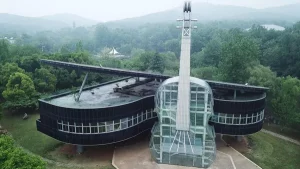
In the city of Huainan, China, stands a remarkable architectural feat that pays homage to the harmony between music and architecture. Known as the Piano House, this whimsical structure features a grand piano-shaped exterior with a glass violin perched atop it. Designed by local architects, the building serves as a music school and concert hall, inviting visitors to explore its unique blend of art and architecture while enjoying performances by local musicians.
9. The Bubble House (Tourrettes-sur-Loup, France)

Perched atop a hillside in Tourrettes-sur-Loup, France, the Bubble House is a futuristic residence that resembles a cluster of giant bubbles frozen in mid-air. Designed by Hungarian architect Antti Lovag, this unconventional dwelling eschews traditional right angles and sharp corners in favor of organic, curvilinear forms. The interior spaces flow seamlessly into one another, blurring the boundaries between indoors and outdoors and creating a sense of fluidity and openness.
10. The Atomium (Brussels, Belgium)
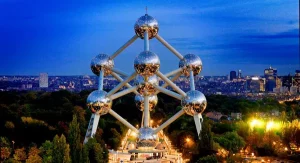
Rising majestically above the skyline of Brussels, Belgium, the Atomium is a striking architectural landmark that embodies the spirit of the Atomic Age. Designed by engineer André Waterkeyn for the 1958 Brussels World’s Fair, this colossal structure resembles a giant atom magnified 165 billion times, with interconnected spheres housing exhibition spaces and observation decks. Despite its futuristic appearance, the Atomium has become an enduring symbol of Belgium’s cultural heritage and scientific prowess.
In conclusion, the world is replete with architectural wonders that defy convention and challenge our perceptions of space and form. From whimsical cottages to gravity-defying houses, these ten weirdest architectures serve as testaments to human creativity, imagination, and the boundless possibilities of design. As we continue to push the boundaries of architectural innovation, these extraordinary structures remind us that the greatest wonders often lie beyond the realms of convention and conformity.
You Might Be Interested In:



























